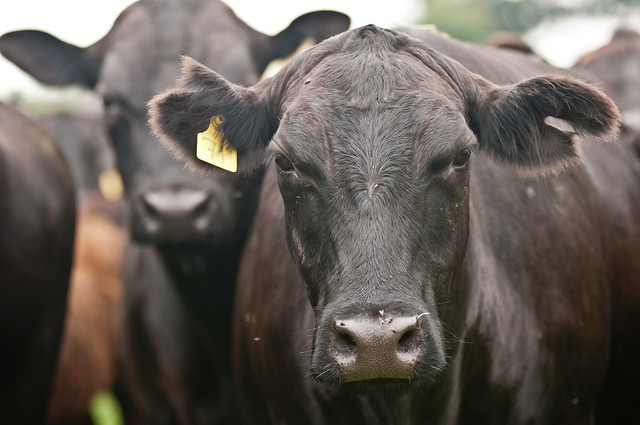I have to confess that I have been wary of the term “efficiency” in agriculture, since in my mind it is inexorably linked to consolidation, economies of scale leading to factory farming and mono-cultures, and cost-cutting measures that might ignore social and environmental externalities.
However, my seminar yesterday made me rethink and re-evaluate – to what extent could the quest for efficiency be a sister concept, and indeed a precondition for sustainable farming?

Image by USDA, via Flickr CC.
To understand this point of view, it might be necessary to specify some definitions – our lecturers spoke first of input efficiency, where optimality means to use the smallest amount of inputs necessary to produce a certain output, and then of output efficiency, where you produce optimally if you are able to create the largest possible amount of output with a given input.
Thus, as the researchers explained in response to a question of mine, efficiency can be seen as essential for sustainable farming practices since it means that you are not wasting any resources – you are using just the right amount of, for example, fertilizer, pesticides, land and water in order to produce your crops. This helps reduce pressures on the environment (since you are using and polluting less per unit of output produced), enables farmers to maximize their profit margins (supporting economic sustainability), and through fostering rural communities can also contribute to social sustainability.
A similar argument was presented to us by the Head of the Sustainability department at Arla Foods, a Swedish-Danish dairy cooperative (and sixth-largest dairy producer worldwide!) who was describing a huge new dairy processing unit that they are building in England. Apparently, they have high hopes of making the entire facility carbon-neutral, but even under normal conditions consolidation like this, according to his presentation, vastly enhances the resource use compared to the operation of numerous small facilities. The downside he mentioned, though, is the huge amount of trucks bringing milk to and dairy products from the facility – I wonder whether those transportation costs (CO2 – wise) were included when they made the sustainability assessment?
Or then there is the case of the carbon footprint of different foods, which shows that organic beef is more carbon-intensive than conventional beef – mainly because the cows live longer, producing more methane in their lifespan. Living longer also means that they eat more, so from a feed input perspective organic farming is less ‘efficient’. Yet, it doesn’t use any pesticides – cost-saving – but does use more labor – cost-increasing. So does that mean that organic beef is less “sustainable”? How do we weigh different factors against each other? Solely by the monetary value of them?
The seminar brought up two different solutions. In one Swedish research project, the researchers measured ‘output’ in revenue terms – basically, a farm’s ‘output’ was how much they earned. They included one key element – farm subsidies. While some of those are attributed on a per-head or per-acre measure (direct payments), others directly reward agro-ecological measures (such as organic farming practices or the preservation of habitats), thus reflecting societal values on ideal production systems. ‘Efficiency’ is then compared according to a ratio of input costs and the top revenues (which reflect ‘best practice production’), and evaluated on how close producers are to achieving the industry-specific best practice. According to the analyses, farmers are pretty homogeneous (achieving on average 80 – 90% of the top ratios) when taking subsidies into account – a sign both that the subsidy system is working well at equilibrating farm incomes (which is one of its stated goals), but also that it is not bad at balancing the different priorities (keeping in mind that there is still a lot that could be fixed in the EU subsidy system – a different post for a different time).
Then, the other researcher brought up the concept of ‘rational inefficiencies‘. You see, as economists, we love to assume that people make rational decisions (Ridiculous.) And then, we assume that because people are rational, they will want to make efficient choices (profit-maximizing, utility-maximizing, cost-minimizing, etc.) (I know.) But a new field of agricultural economics research is now discovering that farmers could make “suboptimal” choices because they derive utility (pleasure) from the activity itself (so-called on-farm consumption) – and thus decide to spend more time with their animals than minimally necessary (because they like working with animals), do more work than required in planting different varieties (because they enjoy acting as a steward for the land), or – counter-example – buy the huge and shiny John Deere tractor despite the fact that a smaller used one would be more efficient because they love showing off their gear. Sigh. I love being at the forefront of academic discovery. Oh, by the way – there is a formula for that. This link will take you there if you are so inclined.
I guess my take-away from yesterday is that it’s more complicated that it appears to be. As always. Efficient can mean resource-saving, green and linked to a circular economy framework, but it could also mean cutting corners that shouldn’t be cut. And as always, it’s very probable that a simple regression equation won’t be able to sum up the complexity of agriculture. But that doesn’t mean that agricultural economists will stop trying 😉